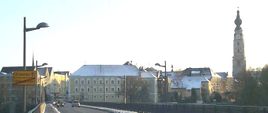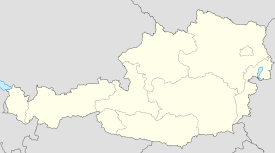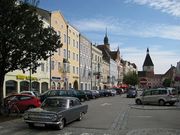Braunau am Inn
| Braunau am Inn | |
 |
|
 |
|
 Braunau am Inn
|
|
| Country | |
|---|---|
| State | Upper Austria |
| District | Braunau am Inn |
| Mayor | Gerhard Skiba (SPÖ) |
| Area | 24.8 km2 (9.6 sq mi) |
| Elevation | 351 m (1152 ft) |
| Population | 17,333 (14 February 2011) |
| - Density | 699 /km² (1,810 /sq mi) |
| Time zone | CET/CEST (UTC+1/+2) |
| Licence plate | BR |
| Postal code | 5280 |
| Area code | 07722 |
| Website | www.braunau.at |
Braunau am Inn is a city in the Innviertel region of Upper Austria (Oberösterreich), the north-western state of Austria. It lies about 90 km west of Linz and about 60 km north of Salzburg, on the border with the German state of Bavaria. The population in 2001 was 16,372. A port of entry, it is connected by bridges over the Inn River with its Bavarian counterpart, Simbach am Inn. It is well-known as the birthplace of Adolf Hitler.
History

The town was first mentioned around 810 and received the city statute in 1260, which makes it one of the oldest cities in Austria. It became a fortress city and important trading route junction, dealing with the salt trade and with ship traffic on the River Inn.
Throughout its history it changed hands four times. It was Bavarian until 1779 and became an Austrian town under the terms of the treaty of Teschen, which settled the War of the Bavarian Succession. As a major Bavarian city, the town played an outstanding role in the Bavarian uprising against the Austrian occupation during the War of the Spanish Succession, when it hosted the Braunau Parliament, a provisional Bavarian Parliament in 1705 headed by Georg Sebastian Plinganser born 1680 in Pfarrkirchen; and died 7 May 1738 in Augsburg. Under the terms of the treaty of Pressburg, Braunau became Bavarian again in 1809. In 1816, during reorganization of Europe after the Napoleonic Wars, Bavaria ceded the town to Austria and was compensated by the gain of Aschaffenburg. Braunau has been an Austrian city ever since.
Braunau has a remarkable 15th-century church with a 99m-high spire, the third highest in Austria. Its patron saint is St. Stephen. The remains of a castle house a museum and parts of the former town walls can still be seen. Another museum is housed in refurbished 18th century public baths.
Adolf Hitler was born in Braunau am Inn on 20 April 1889. He and his family left Braunau and moved to Linz in 1894. In 1989 the new mayor Gerhard Skiba took the initiative and placed a memorial stone commemorating the victims of World War II in front of the building in which Hitler was born. The stone is made of granite from the Mauthausen concentration camp. It states, Für Frieden, Freiheit und Demokratie. Nie wieder Faschismus. Millionen Tote mahnen, or "For peace, freedom and democracy; millions of dead urge: never again fascism." It is often vandalized by members of neo-Nazi groups.
In 1938, Ranshofen, which at that time had one of Austria's largest aluminum plants, was annexed to Braunau. In 1948 Braunau had a population of 11,744.
Braunau has a full range of industries including electronics, metal (AMAG), woodworking, and glass. The town also has the largest aluminium works in Austria.
After two successful seasons, the local football (soccer) team, S.V. Braunau, reached the Austrian 1st Division before suddenly going bankrupt in 2000. The team was refounded as F.C. Braunau.
External links
|
|||||